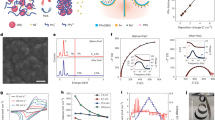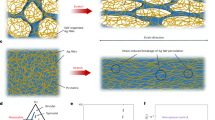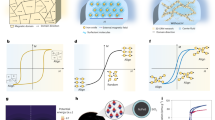Abstract
Narrowing the mechanical mismatch between tissue and implantable microelectronics is essential for reducing immune responses and for accommodating body movement. However, the design of implantable soft electronics (on the order of 10 kPa in modulus) remains a challenge because of the limited availability of suitable electronic materials. Here, we report electrically conductive hydrogel-based elastic microelectronics with Young’s modulus values in the kilopascal range. The system consists of a highly conductive soft hydrogel as a conductor and an elastic fluorinated photoresist as the passivation insulation layer. Owing to the high volumetric capacitance and the passivation layer of the hydrogel, electrode arrays of the thin-film hydrogel ‘elastronics’, 20 μm in feature size, show a significantly reduced interfacial impedance with tissue, a current-injection density that is ~30 times higher than that of platinum electrodes, and stable electrical performance under strain. We demonstrate the use of the soft elastronic arrays for localized low-voltage electrical stimulation of the sciatic nerve in live mice.
This is a preview of subscription content, access via your institution
Access options
Access Nature and 54 other Nature Portfolio journals
Get Nature+, our best-value online-access subscription
$29.99 / 30 days
cancel any time
Subscribe to this journal
Receive 12 digital issues and online access to articles
$99.00 per year
only $8.25 per issue
Buy this article
- Purchase on Springer Link
- Instant access to full article PDF
Prices may be subject to local taxes which are calculated during checkout





Similar content being viewed by others
Data availability
The authors declare that all data supporting the findings of this study are available within the paper and its Supplementary Information.
References
Kringelbach, M. L., Jenkinson, N., Owen, S. L. F. & Aziz, T. Z. Translational principles of deep brain stimulation. Nat. Rev. Neurosci. 8, 623–635 (2007).
Borovikova, L. V. et al. Vagus nerve stimulation attenuates the systemic inflammatory response to endotoxin. Nature 405, 458–462 (2000).
Lacour, S. P., Courtine, G. & Guck, J. Materials and technologies for soft implantable neuroprostheses. Nat. Rev. Mater. 1, 16063 (2016).
FeinerR. & Dvir, T. Tissue-electronics interfaces: from implantable devices to engineered tissues. Nat. Rev. Mater. 3, 17076 (2017).
Salatino, J. W., Ludwig, K. A., Kozai, T. D. Y. & Purcell, E. K. Glial responses to implanted electrodes in the brain. Nat. Biomed. Eng. 1, 862–877 (2017).
Someya, T., Bao, Z. & Malliaras, G. G. The rise of plastic bioelectronics. Nature 540, 379–385 (2016).
Khodagholy, D. et al. NeuroGrid: recording action potentials from the surface of the brain. Nat. Neurosci. 18, 310–315 (2015).
Canales, A. et al. Multifunctional fibers for simultaneous optical, electrical and chemical interrogation of neural circuits in vivo. Nat. Biotechnol. 33, 277–284 (2015).
Kim, J. et al. Stretchable silicon nanoribbon electronics for skin prosthesis. Nat. Commun. 5, 5747 (2014).
Xu, L. et al. 3D multifunctional integumentary membranes for spatiotemporal cardiac measurements and stimulation across the entire epicardium. Nat. Commun. 5, 3329 (2014).
Liu, J. et al. Syringe-injectable electronics. Nat. Nanotechnol. 10, 629–636 (2015).
Minev, I. R. et al. Electronic dura mater for long-term multimodal neural interfaces. Science 347, 159–163 (2015).
Hong, G., Yang, X., Zhou, T. & Lieber, C. M. Mesh electronics: a new paradigm for tissue-like brain probes. Curr. Opin. Neurobiol. 50, 33–41 (2018).
Jeong, J. W. et al. Soft materials in neuroengineering for hard problems in neuroscience. Neuron 86, 175–186 (2015).
Caliari, S. R. & Burdick, J. A. A practical guide to hydrogels for cell culture. Nat. Methods 13, 405–414 (2016).
Sharma, B. et al. Human cartilage repair with a photoreactive adhesive-hydrogel composite. Sci. Transl Med. 5, 167ra6 (2013).
Yuk, H., Zhang, T., Lin, S., Parada, G. A. & Zhao, X. Tough bonding of hydrogels to diverse non-porous surfaces. Nat. Mater. 15, 190–196 (2015).
Kang, H.-W. et al. A 3D bioprinting system to produce human-scale tissue constructs with structural integrity. Nat. Biotechnol. 34, 312–319 (2016).
Keplinger, C. et al. Stretchable, transparent, ionic conductors. Science 341, 984–987 (2013).
Sekine, S., Ido, Y., Miyake, T., Nagamine, K. & Nishizawa, M. Conducting polymer electrodes printed on hydrogel. J. Am. Chem. Soc. 132, 13174–13175 (2010).
Sasaki, M. et al. Highly conductive stretchable and biocompatible electrode–hydrogel hybrids for advanced tissue engineering. Adv. Healthc. Mater. 3, 1919–1927 (2014).
Abidian, M. R. et al. Hybrid conducting polymer-hydrogel conduits for axonal growth and neural tissue engineering. Adv. Healthc. Mater. 1, 762–767 (2012).
Hassarati, R. T. et al. Improving cochlear implant properties through conductive hydrogel coatings. IEEE Trans. Neural Syst. Rehabil. Eng. 22, 411–418 (2014).
Abidian, M. R. & Martin, D. C. Multifunctional nanobiomaterials for neural interfaces. Adv. Funct. Mater. 19, 573–585 (2009).
Feig, V. R., Tran, H., Lee, M. & Bao, Z. Mechanically tunable conductive interpenetrating network hydrogels that mimic the elastic moduli of biological tissue. Nat. Commun. 9, 2740 (2018); correction 9, 5030 (2018).
Green, R. A. et al. Conductive hydrogels: mechanically robust hybrids for use as biomaterials. Macromol. Biosci. 12, 494–501 (2012).
Amella, A. D. et al. Freestanding, soft bioelectronics. In Proc. 7th International IEEE/EMBS Conference on Neural Engineering (NER) 607–610 (IEEE, 2015).
Ding, H. et al. Biologically derived soft conducting hydrogels using heparin-doped polymer networks. ACS Nano 8, 4348–4357 (2014).
Kim, D. H., Abidian, M. & Martin, D. C. Conducting polymers grown in hydrogel scaffolds coated on neural prosthetic devices. J. Biomed. Mater. Res. A 71, 577–585 (2004).
Kim, D. H., Wiler, J. A., Anderson, D. J., Kipke, D. R. & Martin, D. C. Conducting polymers on hydrogel-coated neural electrode provide sensitive neural recordings in auditory cortex. Acta Biomater. 6, 57–62 (2010).
Guiseppi-Elie, A. Electroconductive hydrogels: synthesis, characterization and biomedical applications. Biomaterials 31, 2701–2716 (2010).
Chung, D. Materials for Electronic Packaging (Butterworth-Heinemann, Newton, 1995).
Yu, D., Yang, Y. Q., Chen, Z., Tao, Y. & Liu, Y. F. Recent progress on thin-film encapsulation technologies for organic electronic devices. Opt. Commun. 362, 43–49 (2016).
Wang, Y. et al. A highly stretchable, transparent, and conductive polymer. Sci. Adv. 3, e1602076 (2017).
Mawad, D., Lauto, A. & Wallace, G. G. in Polymeric Hydrogels as Smart Biomaterials (ed. Kalia, S.) 19–45 (Springer, New York, 2016).
Strakosas, X. et al. A facile biofunctionalisation route for solution processable conducting polymer devices. J. Mater. Chem. B 2, 2537–2545 (2014).
Khodagholy, D. et al. High transconductance organic electrochemical transistors. Nat. Commun. 4, 2133 (2013).
Akhtar, R., Sherratt, M. J., Cruickshank, J. K. & Derby, B. Characterizing the elastic properties of tissues. Mater. Today 14, 96–105 (2011).
Patil, A. C. & Thakor, N. V. Implantable neurotechnologies: a review of micro- and nanoelectrodes for neural recording. Med. Biol. Eng. Comput. 54, 23–44 (2016).
Pan, L. et al. Hierarchical nanostructured conducting polymer hydrogel with high electrochemical activity. Proc. Natl Acad. Sci. USA 109, 9287–9292 (2012).
Green, R. A., Baek, S., Poole-Warren, L. A. & Martens, P. J. Conducting polymer-hydrogels for medical electrode applications. Sci. Technol. Adv. Mater. 11, 014107 (2010).
Yang, J., Choe, G., Yang, S., Jo, H. & Lee, J. Y. Polypyrrole-incorporated conductive hyaluronic acid hydrogels. Biomater. Res. 20, 31 (2016).
Chen, R., Canales, A. & Anikeeva, P. Neural recording and modulation technologies. Nat. Rev. Mater. 2, 16093 (2017).
Green, R. A. et al. Substrate dependent stability of conducting polymer coatings on medical electrodes. Biomaterials 33, 5875–5886 (2012).
Yamato, H., Ohwa, M. & Wernet, W. Stability of polypyrrole and poly(3,4-ethylenedioxythiophene) for biosensor application. J. Electroanal. Chem. 397, 163–170 (1995).
Thaning, E. M., Asplund, A. L. M., Nyberg, T. A., Inganäs, O. W. & von Holst, H. Stability of poly(3,4-ethylene dioxythiophene) materials intended for implants. J. Biomed. Mater. Res. B Appl. Biomater. 93, 407–415 (2010).
Xiao, Y. et al. Synthesis and characterization of p-toluenesulfonate incorporated poly(3,4-ethylenedioxythiophene). Talanta 72, 532–538 (2007).
Cogan, S. F. Neural stimulation and recording electrodes. Annu. Rev. Biomed. Eng. 10, 275–309 (2008).
Wilks, S. Poly(3,4-ethylene dioxythiophene) (PEDOT) as a micro-neural interface material for electrostimulation. Front. Neuroeng. 2, 7 (2009).
Rose, T. L. & Robblee, L. S. Electrical stimulation with Pt electrodes. VIII. Electrochemically safe charge injection limits with 0.2 MS pulses. IEEE Trans. Biomed. Eng. 37, 1118–1120 (1990).
Goding, J., Gilmour, A., Martens, P., Poole-Warren, L. & Green, R. Interpenetrating conducting hydrogel materials for neural interfacing electrodes. Adv. Healthc. Mater. https://doi.org/10.1002/adhm.201601177 (2017).
Mario Cheong, G. L. et al. Conductive hydrogels with tailored bioactivity for implantable electrode coatings. Acta Biomater. 10, 1216–1226 (2014).
Grill, W. M. & Mortimer, J. T. Neural and connective tissue response to long-term implantation of multiple contact nerve cuff electrodes. J. Biomed. Mater. Res. 50, 215–226 (2000).
Agnew, W. F., McCreery, D. B., Yuen, T. G. H. & Bullara, L. A. Histologic and physiologic evaluation of electrically stimulated peripheral nerve: considerations for the selection of parameters. Ann. Biomed. Eng. 17, 39–60 (1989).
Larsen, J. O., Thomsen, M., Haugland, M. & Sinkjær, T. Degeneration and regeneration in rabbit peripheral nerve with long-term nerve cuff electrode implant: a stereological study of myelinated and unmyelinated axons. Acta Neuropathol. 96, 365–378 (1998).
Schwarz, D. A. et al. Chronic, wireless recordings of large-scale brain activity in freely moving rhesus monkeys. Nat. Methods 11, 670–676 (2014).
Lee, H., Bellamkonda, R. V., Sun, W. & Levenston, M. E. Biomechanical analysis of silicon microelectrode-induced strain in the brain. J. Neural. Eng. 2, 81–89 (2005).
Rousche, P. J. et al. Flexible polyimide-based intracortical electrode arrays with bioactive capability. IEEE Trans. Biomed. Eng. 48, 361–370 (2001).
Luan, L. et al. Ultraflexible nanoelectronic probes form reliable, glial scar–free neural integration. Sci. Adv. 3, e1601966 (2017).
Zhou, T. et al. Syringe-injectable mesh electronics integrate seamlessly with minimal chronic immune response in the brain. Proc. Natl Acad. Sci. USA 114, 5894–5899 (2017).
Rivnay, J. et al. Structural control of mixed ionic and electronic transport in conducting polymers. Nat. Commun. 7, 11287 (2016).
Rivnay, J. et al. High-performance transistors for bioelectronics through tuning of channel thickness. Sci. Adv. 1, e1400251 (2015).
Rivnay, J., Wang, H., Fenno, L., Deisseroth, K. & Malliaras, G. G. Next-generation probes, particles, and proteins for neural interfacing. Sci. Adv. 3, e1601649 (2017).
Abidian, M. R. & Martin, D. C. Experimental and theoretical characterization of implantable neural microelectrodes modified with conducting polymer nanotubes. Biomaterials 29, 1273–1283 (2008).
Williamson, A. et al. Localized neuron stimulation with organic electrochemical transistors on delaminating depth probes. Adv. Mater. 27, 4405–4410 (2015).
Mawad, D. et al. A conducting polymer with enhanced electronic stability applied in cardiac models. Sci. Adv. 2, e1601007 (2016).
Hu, Z. et al. Photochemically cross-linked perfluoropolyether-based elastomers: synthesis, physical characterization, and biofouling evaluation. Macromolecules 42, 6999–7007 (2009).
Acknowledgements
This work was partly supported by a Bio-X Interdisciplinary Initiatives Seed Grant and by BOE Technology Group Co., Ltd. Part of this work was performed at the Stanford Nano Shared Facilities (SNSF), supported by the National Science Foundation under award ECCS-1542152. Y.L. is supported by a National Science Scholarship (A*STAR, Singapore). H.W. is supported by a NIH NRSA F32 postdoctoral fellowship. A.M.F. thanks the Natural Sciences and Engineering Research Council (NSERC) of Canada for a postdoctoral fellowship. X.W. is supported by a Life Science Research Foundation fellowship and the Gordon and Betty Moore Foundation. We thank X. Liu, Y. Li and K. Zhang from the BOE Technology Group Co., LTD for discussions, A. Tom for assistance with some experiments, and Daikin Co. and Solvay for supplying PFPE-diols.
Author information
Authors and Affiliations
Contributions
Y.L., J.L. and Z.B. designed the project and experiments. Y.L. synthesized the MECH. J.L. and T.L. synthesized the elastic fluorinated photoresist. Y.L. and J.L. fabricated the devices. Y.L., J.L., S.C. and Y.K. performed material and device characterization. Y.L., J.L. and A.M.F. prepared the schematics for elastronics and carried out device photography. Y.L., J.L., X.W. and H.W. performed immunofluorescence staining and data analyses. S.N. and Y.L. carried out the simulation of electrochemical impedance. Y.L. and J.L. carried out periphery nerve stimulation experiments on mice and analysed the data. Y.L., J.L., J.B.-H.T. and Z.B. wrote the manuscript. All authors reviewed and commented on the manuscript.
Corresponding author
Ethics declarations
Competing interests
Stanford University has filed patent applications related to this technology. The patent application number is PCT/US2018/057855.
Additional information
Publisher’s note: Springer Nature remains neutral with regard to jurisdictional claims in published maps and institutional affiliations.
Supplementary information
Supplementary Information
Supplementary figures and video captions
Supplementary Video 1
Anisotropic swelling of the MECH material
Supplementary Video 2
Electrical stimulation with the MECH electrode on the mouse sciatic nerve elicits toe movement
Supplementary Video 3
Comparison of electrical-stimulation efficiency of the MECH electrode and of a platinum electrode with the same electrode area on the mouse sciatic nerve
Rights and permissions
About this article
Cite this article
Liu, Y., Liu, J., Chen, S. et al. Soft and elastic hydrogel-based microelectronics for localized low-voltage neuromodulation. Nat Biomed Eng 3, 58–68 (2019). https://doi.org/10.1038/s41551-018-0335-6
Received:
Accepted:
Published:
Issue Date:
DOI: https://doi.org/10.1038/s41551-018-0335-6
This article is cited by
-
Soft high-density neural probes enable stable single-neuron recordings
Nature Nanotechnology (2024)
-
Phase-separated stretchable conductive nanocomposite to reduce contact resistance of skin electronics
Scientific Reports (2024)
-
Multilayer stretchable electronics with designs enabling a compact lateral form
npj Flexible Electronics (2024)
-
Neuromorphic hardware for somatosensory neuroprostheses
Nature Communications (2024)
-
3D spatiotemporally scalable in vivo neural probes based on fluorinated elastomers
Nature Nanotechnology (2024)



